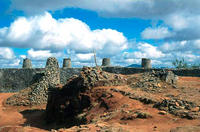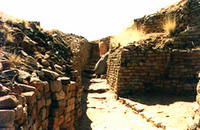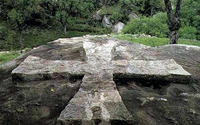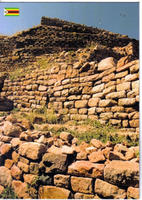You are in: Africa -> Zimbabwe -> Khami Ruins National... , and traditional search or Image Gallery will yield results of this site only
Khami Ruins National Monument
| Site number: | 365 |
|
| Type of site: | Cultural | |
| Date: | 16th century | |
| Date of Inscription: | 1986 | |
| Location: | Africa, Zimbabwe, Western Region, Matabeleland | |
Up to 75 images are shown here. Click on each for more details or on Image Gallery for more images.
| Description: | The archaeologically fascinating Khami was developed following the desertion of Great Zimbabwe’s capital in the mid-16th century. The unearthing of European and Chinese objects illustrates that Khami was a foremost centre for trade over an extended period of time. --WHMNet paraphrase from the description at WHC Site, where additional information is available. | |
| Khami is a ruined city in southern Africa, in what is now western and central Zimbabwe. It is located 22 kilometers west of the modern city of Bulawayo, capital of the province of Matabeleland North. Its ruins are now a national monument in Zimbabwe. Khami is also a UNESCO World Heritage Site. It was added to UNESCO's World Heritage List in 1986. The settlement that we see today was a development of the architectural form that emerged at Great Zimbabwe in the 13th century AD. The structure and style of the buildings (very little but foundations and pavements survive) show some original solutions to the problems of building in dry stone although the overall impression is of a poorer and less grand society than the one at Great Zimbabwe. Its architecture is an innovation from Great Zimbabwe. This innovation arose out of the environment in which the city was built. With Matopan granite which is harder to quarry it was difficult to make flat stone blocks to build free-standing walls. The stones they quarried were from parent rock that exfoliates like onions following the circular nature of the rock. This was suitable for building platforms but not for free standing walls. There were also no flat hills from which to build so the broken Matopan environment had to tamed by filling up the areas in between the boulders with stones and soil. This shortage of good quality stone meant that almost all the buildings were constructed of wood-reinforced mud, of which no examples survive on the site. The town appears to have been founded at the time of the disappearance of the state at Great Zimbabwe, it grew between 1450 and 1650. Khami was the capital of the Torwa dynasty for about 200 years from around 1450. After that, (the traditional date is 1683), it was ransacked by Changamire Dombo who led an army of WaRozwi rebels from the Munhumutap/Mwenemutapa/Monomotapa State. Excavations seem to show that the site was not occupied after these Rozvi took over. The Rozvi made another Khami phase site, Danamombe (Dhlo-Dhlo), their new capital. --Wikipedia. Text is available under the Creative Commons Attribution-ShareAlike License. | ||
| Source: | http://whc.unesco.org/en/list/365 | |
| Reference: | 1. UNESCO World Heritage Center, Site Page. | |









